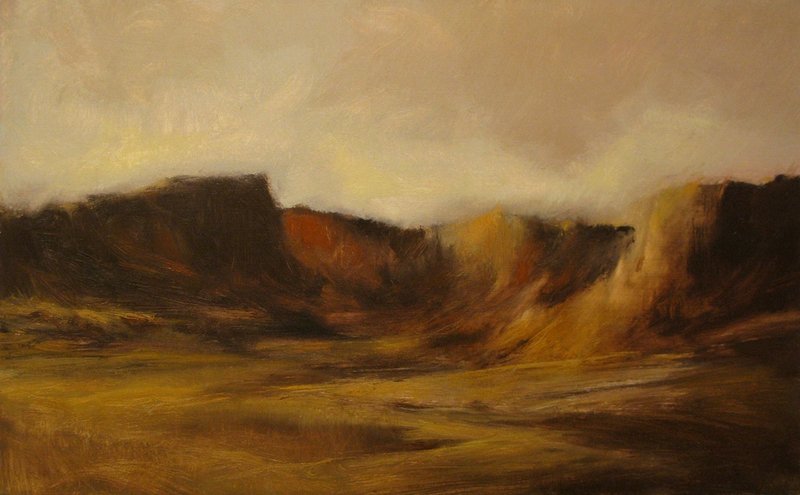Less than 100 years ago, a Russian artist, Kazimir Malevich, painted a black square on a white canvas. It was one of the most dramatic and influential breakthroughs in the history of art.
It isn’t merely some graphic with hard edges. The black and the white are loosely painted, and the lines aren’t fussy. It’s a great painting that exudes joy and freedom, and it happens to be my favorite painting in the world. But I also love brushy representation, such as anything by John Singer Sargent.
Dennis Pinette’s new landscapes at Rockland’s Caldbeck Gallery are examples of work that ride on Sargent-style virtuoso brushwork. I like the new show less than his burning barns, but some of the work — like his “Hot Gravel Pit July 2010” — is extremely strong.
The gravel pit features a hot-colored palette mixed with earth tones. It is a sweeping, if sweltering, image. While it is a stable landscape devoid of any people or growth, as an image it roils like angry sea, only hot and dry — but just as inhospitable and violent.
As a viewer, my response is to be impressed by Pinette’s ability to handle a brush and push paint around on a canvas. But sometimes I like to be alone with the work rather than find myself standing in the shadows of the artist and his bravura. This is why I like Pinette’s work better when it shares a scene with us: our own vision becomes just as valid as his.
THE GREAT GREENLEAF
While Pinette’s show now fills Caldbeck’s handsome main gallery, there is also a truly great show on the second floor of work by Ken Greenleaf. It is steeped in the abstract tradition started by Malevich: black geometrical forms, in this case on raw, shaped canvases.
While they have had little to do with Maine’s formidable history of painting, shaped canvases were practically the norm of ambitious, major paintings in the 1960s as practiced by the likes of Frank Stella, Ken Noland, Ellsworth Kelly, Robert Mangold and so many others.
Greenleaf’s “Section,” for example, is a lilting trapezoid that is thinner at the top. It is about 2 feet tall and wide. The raw canvas is stretched perfectly around the 1-inch-thick support. Black paint covers the top of the work and reaches down as the leg of a sharper trapezoid towards the bottom left of the canvas, barely and electrically lifting away from the lower-left edge. While my description might sound jumbled, I assure you the painting is not. It is confident, clear, beautiful and smart.
The obvious variable that makes this body of work so interesting is the way the black forms reach over the edge. Artists often use the edge of paintings, but rarely with so much of an impact on the image. Stepping to the right of “Port” shifts the top of the black form into the upper edge of a claw. It completely changes the direction and motion of the work.
One piece I found to be particularly appealing is “Trajectory.” It is another trapezoidal canvas — thinner on the right. The black form is a triangle with its thickest side on the right and an extended neck that alone reaches over the left edge of the canvas. As you move to the left to follow it, the form and the painting both expand and pick up speed. It is brilliant and thoroughly enjoyable.
Greenleaf was a highly successful sculptor in New York in the 1970s and ’80s, and he did us the favor of including a piece from 1972 in this show. The terrific little sculpture (reminiscent of Tony Caro) is an excellent reminder of how Greenleaf is extremely studied in composing in the round. Seeing the pieces from the side doesn’t just shift Greenleaf’s paintings. They often change completely, and wear the multiple suits extremely well.
Greenleaf has also included three collages; again, black on white. These may or may not reveal something about his technique, but they are obviously created from many bits of thick black paper that reveal their white edges when placed together.
Rather than the complete and singular black forms of the paintings, the collages appear to have been made like additive sculpture. While the paintings could be works of design or even architecture, the collages make a strong case for Greenleaf’s sculptural predilection.
What really strikes me about this body of Greenleaf’s work is its attitude. Hard-edged geometrical abstraction tends to be serious and intellectual. It’s tough to imagine that black shapes on raw canvas can be joyous, sensual and exciting, but this is the case with Greenleaf’s work now at Caldbeck.
They are great paintings in a great little show: smart, savvy and delicious.
Freelance writer Daniel Kany is an art historian who lives in Cumberland. He can be contacted at:
dankany@gmail.com
Send questions/comments to the editors.



Success. Please wait for the page to reload. If the page does not reload within 5 seconds, please refresh the page.
Enter your email and password to access comments.
Hi, to comment on stories you must . This profile is in addition to your subscription and website login.
Already have a commenting profile? .
Invalid username/password.
Please check your email to confirm and complete your registration.
Only subscribers are eligible to post comments. Please subscribe or login first for digital access. Here’s why.
Use the form below to reset your password. When you've submitted your account email, we will send an email with a reset code.